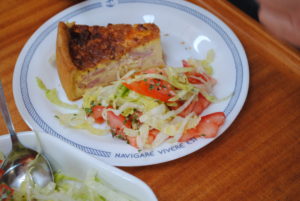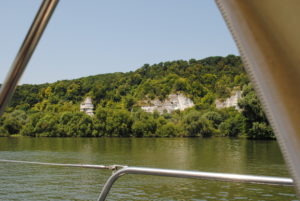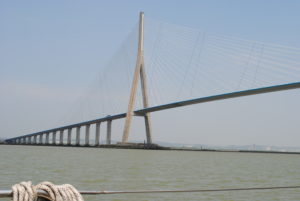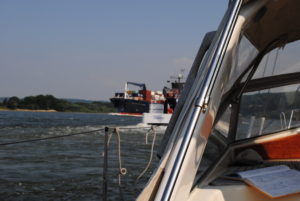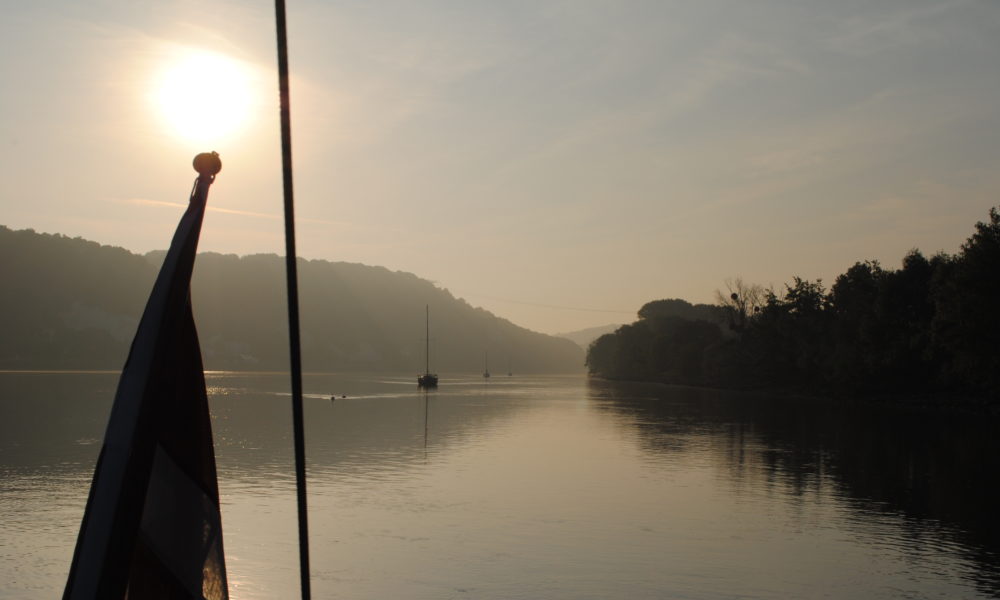
Tidal Seine is rough, desolate and magnificent nature
49° 29′ 39.732” N 0° 6′ 28.5444” E
July 18. – 2013
We had already asked for advice at the port office. “Go at low tide minus two hours,” they told us. Low tide in Le Havre on July 18 is 13.22. Minus two hours is 11.22. As a precaution, we leave at 11.15. It gave us the time for a quiet morning with a long run along the seafront in Le Havre, bath and breakfast.
The two hours before low tide, we use at getting to the entrance of the Seine. In the river there are some scary areas with shallow water, and it was explained to us, that they move from year to year, so as a precaution we have to sail far out into the English Channel before we swing into the entrance to Seine.
It turns out that there are two factors working against us. Today it is neaps. This happens once a month and means that the tidal current is less strong than normal – and therefore we get less co-current flow. At the same time, the wind is strong – 9-11 metres per second – and it slows our speed, as the wind mostly goes against us.
Therefore, we are not reaching today’s goal, Rouen, but have to moor Ronja to an anchor buoy some 15 nautical miles before Rouen as the tidal power is strong, and it becomes impossible to reach our goal within a half hour before sunset, which is the limit for boating on the Seine . We tie up to a very beautiful place.
Deciduous trees are all along the riverbank. Direct view of the sunset. Pies, bread and cheese provide an excellent evening meal at about nine.
The part of the Seine, which is called the “tidal Seine” is very special. Far more deserted than we had expected. Raw and steep nature. Not a single house has a boat in the front yard, which we have become accustomed to in Holland. In one day we come across less than a handful of boats like ours but maybe a dozen cargo ships. Beautiful scenery alternates with stinking industrial areas. When we are doing the best we log 9.5 knots. But for long periods we have – because of neaps and headwinds – difficulty to exceed six knots.
The special feature of the 120 kilometres along the Seine up to Rouen is also, that there are practically no places where you can dock or go to port. The back of the Seine estuary is the town of Honfleur. But then follows more than 50 miles without a single port or anchorage. Deserted. It is a pure coincidence that we find a private anchor buoy, which is free and we have no qualms spending our night in a small town called Duclair.
Log-book: Sailed distance: Close to 60 nautical miles. Time: Departure 11.15 from Le Havre. Arrival 20:30 in Duclair. Weather: Wind up to 11 meters per second from the NNE.
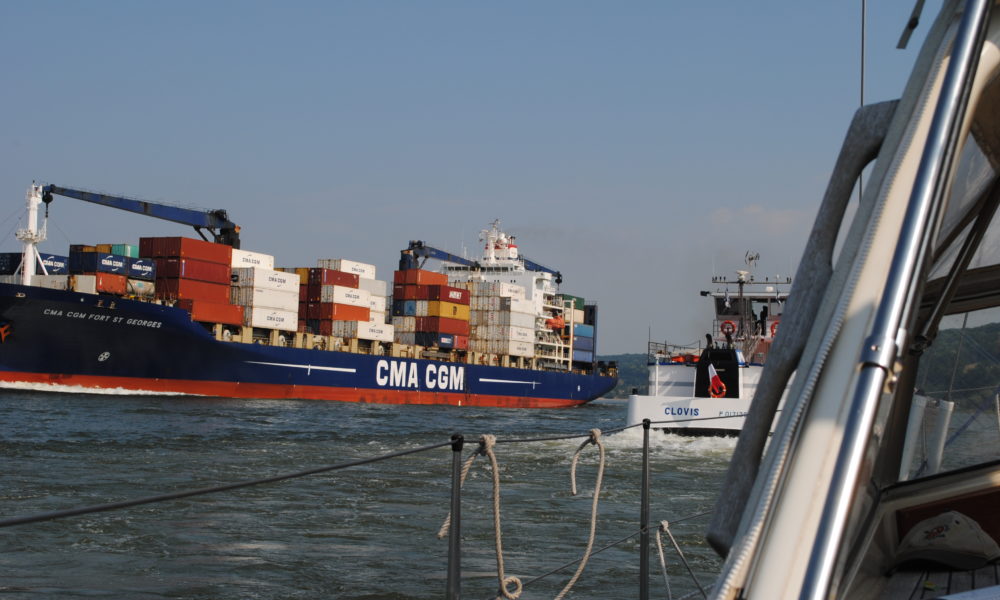
Trend: The further we go south, the higher the price for mooring
49° 55′ 22.7712” N 1° 4′ 38.9388” E
July 17. – 2013
Again, we have problems with the autopilot. We thought that we had solved the problem. But it is still there. In a new form. The autopilot controls the whole game. It is fighting apparently a desperate fight to make the rudder steer a course, that has nothing to do with reality.
Time for the manual again. I hate manuals. We carry out a deviation test by letting “Ronja” sailing around in a circle with two knots – a total round trip of three minutes – while the pilot and the GPS system detects deviation. Then we adjust the indicator again, and we adjust the exchange rate between pilot and GPS as the autopilot consistently believes, that the direction it must follow, is 12 degrees less than what the rest of the GPS system has set.
Several times along the way we think, that we should have a professional Raymarine expert look at the problems. But after some time of experimenting, it seems that we have solved the problem ourselves. And nothing is better than you yourself solving a problem on your own boat.
Today we set sail. Not long. But psychologically it is great to be sailing down through the English Channel.
Le Havre is a large port. For leisure boats it has a huge marina. We walk around the city, we find it difficult to find an absolute centre of the city, but we see many shopping streets, we find a “les halles” market with truly delicious food, and enjoy a beautiful town hall and a theatre house under construction, “Volcan”, which looks like a severed blast furnace from the Ruhr area, and we also take a look inside a church, that looks like a space ship on a launch pad.
It is becoming more and more expensive to moor in a port. In the Netherlands, we paid 11.50 Euro for a night in “Lisse”. We paid 9.30 Euro for an overnight stay in Gouda – beautiful location but not many sanitary facilities. In the City Marina Rotterdam, we paid 27 Euro for a great location and some exceptionally sanitary facilities. In Stichting Veerhaven Rotterdam, we paid 23 Euro for a single button so luxurious accommodation. The Royal Belgian Sailing Club Zeebrugge, Belgium, we paid 28.09 Euro for an overnight stay. In Calais, we paid 23.75 euros per night. In Boulogne-sur-mer, we paid 24 Euros for something that barely was in order. In Port de Dieppe, we paid 30 Euro for a lot of facilities, even though we just used their garbage. And when we arrived at Le Havre, we note that the price has risen to 34 Euro for some services, of which we only used electricity, Internet and water. It is becoming more and more expensive.
It is said that when we reach the Mediterranean, it will get really expensive.
Log-book: Sailed distance: 62 miles. Time: Departure 06.30 from Dieppe. Arrival 14:30 in Le Havre. Weather: Calm, weak sun and tides in our back for the first two thirds of the trip. Then more wind from the northwest, which we tried to take advantage of with the sails.
